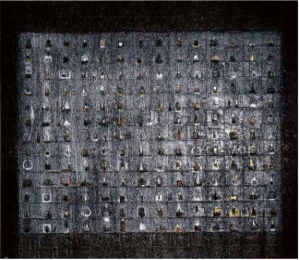
RARE is the opening of an art exhibit where the paintings stun you into silence. No oh’s and ah’s of power-dressed personalities, doing beso-beso, feigning to have truly missed one another for a long time! No shrieks of calculated delight! The conspicuous absence of both the painter and the gallery owner gently coaxed visitors that one comes to a Lao exhibit to see and not to be seen.
Soon, everyone seemed captivated by the silence of the paintings. For there is a silence in painting which, meeting the silence inside oneself, may bring about that supreme surprise—the painting speaks! A painting does speak if only one cares to look and listen. After all, if one takes Lao’s word, a painting is done when it begins to speak. The painting that greets you is aptly entitled “Voices” (7 ft by 8 ft).
It helped that tags were not provided (perhaps intentionally?). One stood clueless before a painting and did not mind teasing out its meaning. Lao is a painter one must grow into. It takes time and patience to become aware Buddha is discreetly present in the painting entitled “Buddha.” As no one peddled a solemn explanation that summed up the paintings, one simply took pleasure viewing them from various angles until one finally saw the “invisible” in the visible. When this happens, one has gone beyond the formulaic to experience the magic of the visual arts.
No staff member supplied a price list and for a while, one ached to figure out how much a square foot of a Lao painting would cost. This augurs well for the art scene today as the first question often asked by buyers, even before seeing the painting, is: “What is the size of the painting?” This is followed by the second question: “How much does it cost?” According to a Chinese belief, to ask the price of a thing is already an admission one cannot afford it.
Whoever started this causal correlation between price and size? The important correlation is not that of price and size. There is a stronger correlation between the quality of the painting and the price. It is not that size does not matter. In this exhibit where there are 14 paintings offered, one will be awed not only by their impeccable workmanship but by their huge dimensions. Three paintings (“Into Light,” “Water” and “Monk’s Table” are 10 feet by 8 feet; two paintings (“Soot” and “Monk’s Table”) are 10 feet by 7 feet; one (“Monk’s Table”) is 5.5 feet by 12 feet. “Water” composed of two rectangles of gray and black (for Lao, water is black) brings to mind Mark Rothko, the only name to be dropped here.
An immense size may pose problems. A Lao collector frantically called his helper to check whether the ceiling in his apartment extended beyond 10 feet. Those collectors who live in condominiums just had to practice resignation that the paintings could not fit into their residences.
Visible touches invisible
At a certain point, a buyer approached me, introduced herself and asked me: “What would you choose? The dramatic-looking “Monk’s Table,” “Soot” or the almost totally black “Monk’s Table.” I answered: “The serene black ‘Monk’s Table.’” To which she immediately countered: “But in terms of resale value, what would you choose?” A wrong question to pose! I mustered enough will power to remain calm and said: “One must buy first because one really likes the painting, takes sheer joy in it, and not because one wants to sell it as soon as possible to make a profit.” I then moved away.
The incident made me reflect throughout the afternoon. When one has the necessary funds and one wants to collect a painting, what should one look for? I should check if the painting stopped me to see, look and listen. I should ask myself: Does it invigorate me, make me feel alive? Does it touch me, provoke me to think, fire my imagination? A painting must speak to me, reveal a meaning or truth that transforms me, changes me. Certainly, Lao ushered me into a new fascinating world where tables support monk’s houses and what look like glimmering temples or mountains. Lao brings us to the edge where the visible touches the invisible—to that place where the deepest things are left unsaid.
I stayed at the exhibition from 2 to 6 p.m. At no time at all were there more than 20 people (including a group of seven, mostly young artists who, being impressed, stayed almost as long as I did). At 6, there were only four paintings left unsold.
Lao challenged me to write only two lines for the catalogue of his exhibition (superb photography by Billy Mondoñedo, book design and annotations by Aman Santos, with an insightful essay by Sandra Palou).
I came up with these six lines, prefaced by a quotation: “Purity of heart is to will one thing—Søren Kierkegaard”:
Take time to listen deeply to these paintings.
Bestow them “that purest and rarest form of generosity”—attention.
Be drawn into a silence that speaks of compassion and joy.
Lao Lianben continues to will only one thing—to render what is “invisible to the eyes.”
Like the empty bowl of a Buddhist monk, his paintings here, in their bare simplicity, offer an inexhaustible feast for thought.
“Lao Lianben, Black Water: A Monk’s Dream” is running at Blanc Art Space, 145 Katipunan Ave. and St. Ignatius Village, Quezon City. Call 09920-9276436, 4425262. E-mail info@blanc.ph; visit www.blanc.ph.
E-mail the author at lgarcia@ateneo.edu.